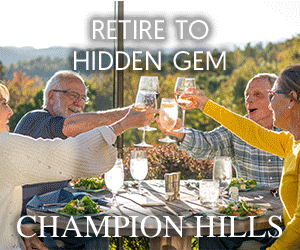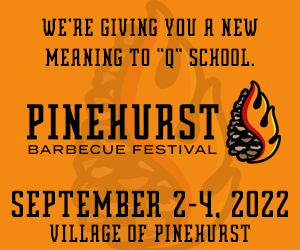The confident words emanating from 90-year-old Peggy Kirk Bell ring just as true as they have for decades of legendary instruction of what we all consider one of the more complex tasks in sports – perfecting the golf swing.
“Keep it simple,” Mrs. Bell says. “I don’t think it’s hard to teach the golf swing. People have a hard time learning it because they want to hit that little ball, and it’s not a hit, it’s a swing.”
Golfers mostly females – have flocked to the Sandhills by the thousands for nearly six decades since Mrs. Bell and high school sweetheart Warren “Bullet” Bell began to grow Pine Needles and Mid Pines into a world-class golf resort.
Mrs. Bell began giving golf lessons in the early 1950s, and at first did it for free. Catch her at the supermarket or around Southern Pines now and she’s more than willing to offer a tip or two to anyone who’ll offer a listening ear.
She recalled that her first paid lesson was $2. Now, one of her top instructors, former LPGA major champion and University of North Carolina star Donna Andrews, receives upwards of $150 per hour.
Times have changed, and so has Mrs. Bell’s technique of reaching her pupils. At first, she balked at instruction, having to be prodded by her husband to take on her first student.
“I was out there hitting golf balls across the second fairway and Bullet came out and said you’ve got to give a golf lesson,” Mrs. Bell recalled. “I told him, ‘I don’t know anything about teaching golf, I’m a player.’ He said, ‘Well, you know more than she does, tell her something.’ So, I went out there … and I told her everything I knew. She kept missing it and missing it. Finally after an hour and a half she asked, ‘Can we quit?’ I said, ‘You sure can.’ I’m sure she quit golf with all that information I gave her. I walked away saying, ‘I’m never going to do that again, I’m a player.’ I used to think you are supposed to be a teacher OR a player. But you better know how to hit it yourself, and that’s what I tell the young teachers. If you can’t show them how to do it how can you expect them to do it? You’ve to show them why it is so easy if they do it right.”
From that day on, Mrs. Bell vowed not to “overload” her students with too much information in a sport with multiple moving parts.
“We turn out people here who understand the swing. Some of them don’t even know the terms or how to run a golf cart when they get here,” Mrs. Bell said. “We have to teach them a lot, but the main thing is to get the rhythm … and the feel and I make them take practice swing after practice swing. A tennis player has to move into it; in golf you have to move into it. Most people never use their feet. It’s because they start in a static position. I try to get them to be in motion. Motion is swing. The secret to golf is having fun, not making it work.”
Mrs. Bell still travels, mostly to see her eight grandchildren participate in various sporting events, including golf tournaments. In that group is Michael McGowan, one of the top players for the University of North Carolina.
“It is amazing how she arises to the occasion,” said daughter Bonnie McGowan. “Activity is great. We keep her busy, keep her going to events. She is almost embarrassed that people make a big deal out of her. She is humble to a point of she doesn’t think she deserves any award. She’s just mom to us.”
Mrs. Bell was certainly an accomplished player, winning the North & South Amateur at Pinehurst, the first LPGA Senior Championship and was a member of the 1950 USGA Curtis Cup team. She tells stories of hanging out with one of the top female athletes of all time – Babe Zaharias – during the infancy of the LPGA Tour.
“We hoped we would get a tournament back then,” Mrs. Bell said of the start of women’s professional golf. “Babe probably did more for the game because she was friendly; she would hit a good shot and turn to the gallery and say, ‘Don’t you boys wish you could hit it like that?’”
Mrs. Bell played with Zaharias on the 1951 LPGA Weathervane Team, traveling to Europe to compete against men.
“There were no girl’s golf teams over there. We played the former Walker Cup players and we beat them,” she said. “I remember Babe beat this guy … he never even went down the 18th fairway, he just got in his car and left the course because she beat him.”
While Bonnie McGowan describes her mother as “ultra competitive” Mrs. Bell’s accomplishments as a golf instructor and ambassador of the game overshadow her playing days.
She is credited with starting the nation’s first golf schools for women at Pine Needles, received the Bobby Jones Award, the highest honor given by the USGA in recognition of distinguish sportsmanship in golf in 1990, and was named PGA of America’s “First Lady of Golf” – a letter of congratulation from the White House in the numerous Pine Needles Lodge trophy cases honoring Mrs. Bell standing as a lasting tribute.
Mrs. Bell has also overseen three U.S. Women’s Open championships at Pine Needles.
“There are few people who are great at one thing,” said son-in-law Pat McGowan, himself a former PGA and Champions Tour winner. “But it is extremely rare when you are great at two things. Mom was a great player and she’s a great teacher.”
For now, Mrs. Bell is determined to recover from a pair of 2010 knee replacement surgeries, to get back out to the range to start teaching again – on her own two feet.
In addition to daily practice swings in her living room along the 18th fairway at Pine Needles, Mrs. Bell sits on the front of a golf cart, tees up a ball and hits half wedges to stay sharp. It’s ironic that regaining her balance – one of the keys to a smooth and efficient golf swing – is a focal point of her instruction.
“That’s why so many poor players can’t hit it because their balance is bad, they don’t use their legs right,” she says.
At her age, why not just mothball the clubs and enjoy the twilight of smelling freshly cut fairway grass or watching the grandchildren learn the game she loves?
“You can’t quit golf,” Mrs. Bell says with confidence. “I can’t think of anything else to do … that’s why I got both knees done and my hip done 10 years ago. The Lord decides when you die, you don’t decide that. If I had to sit in a wheelchair I would rather die. I’m getting better. I still lose my balance some, but I do exercises every morning. Oh, I’m going to play again. I better or I’ll be mad.”

















